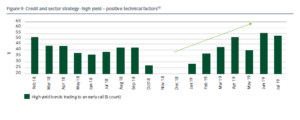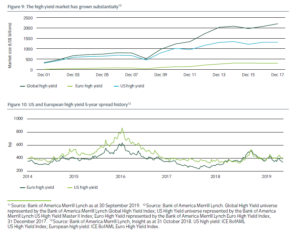
MISPRICING OF OPPORTUNITIES IN SHORTDATED HIGH YIELD
In the investment grade market, credit rating agencies typically assign different credit ratings to the same issuer’s shorter-dated and longer-dated bonds. Pricing of investment grade credit curves is therefore relatively steep – reflecting lower credit spreads on short-dated bonds. However, in high yield, the same dynamic does not apply. Issuers typically receive only a single credit rating for all their debt regardless of maturity. This results in flatter credit curves and, in our view, often disproportionate value in shortdated high yield (Figure 8).
The lack of short-dated high yield bond indices adds to the market’s structural inefficiency. This can provide active managers with opportunities to exploit mispricings in short-dated bonds.
OPPORTUNITIES IN CALLABLE BONDS
Unlike in the investment grade market, most high yield bonds are callable, meaning the issuer has the option of redeeming a bond before the maturity date. This is usually allowable at specific intervals (such as each year) after an initial ‘non-call’ period has elapsed (typically the first three or five years after it has been issued). In practice, this reduces the life of most bonds, as most are called prior to maturity. We seek to identify events that may prompt an issuer to call their bonds.
Debt can be called early for a number of reasons. Lower interest rates typically heightens the market’s expectations for early bond redemptions. When a company’s business develops and its credit quality improves, it may be upgraded or experience a contraction in its credit spreads. Calling its existing debt will allow the company to refinance more cheaply. Figure 9 shows recent trends in the percentage of global high yield bonds trading to an early call. Global central banks’ pivot back to a dovish stance has contributed to the an increase of this percentage in 2019.
Similarly, unlike investment grade debt, high yield bonds typically have a number of structural protections, such as security against underlying assets or covenant protections. Many of these can restrict or deter a company from activity that allows it to pursue growth, such as selling assets pledged as security, paying dividends to shareholders or otherwise assuming greater leverage. If a company’s credit quality has improved, it will likely prefer to refinance with debt that imposes fewer restrictions.
Investors focusing on credit quality can therefore add value by investing in bonds in companies that have an improving credit profile, where they have a strong conviction that its bonds will redeem early. Again, understanding the company’s liquidity position will also provide strong clarity regarding its ability and incentive to repay.
TAKING A FUNDAMENTAL VALUE-DRIVEN APPROACH TO EXPLOIT OPPORTUNITIES
High yield markets are sensitive to shifts in market sentiment, due to their ‘high beta’ nature. Episodes of volatility have been common since the financial crisis and are likely to continue, particularly given considerations such as political risk. For example, following the UK’s referendum on EU membership in June 2016, European high yield credit spreads suddenly widened around 80bp, before recovering almost as sharply. When markets rise or fall, high yield tends to experience inflows or outflows, respectively. Short-dated bonds (which tend to be more liquid) are often impacted first, particularly during a sell-off. This is ironic as they are generally the least likely to be fundamentally impaired if a company’s liquidity position is robust.
However, this creates an opportunity. Investors willing to adopt a contrarian approach during these times may be able to buy bonds cheaply relative to their fundamental value. Similarly, when markets rally, high yield can become expensive. Taking profits and building up significant cash during such episodes (that can be spent during the next sell-off) could be advantageous. A value-based style such as this is counter-intuitive for many investors. It requires diligence, fair-value analysis and rigorous credit work in a market often driven by transient sentiment.
However, such an approach is well-suited to short-dated high yield. This is because credit analysts can acquire an excellent understanding of a bond’s fundamental value based on the issuer’s access to financing options. Furthermore, it can offer the best visibility as to whether an issuer has an improving credit profile that may lead to refinancing a bond early.
HARNESSING VALUE THROUGH A GLOBALLY DIVERSIFIED APPROACH
A global approach to high yield can maximise relative value opportunities, particularly as the global market has matured, making regional diversification compelling. The market value of global high yield markets has roughly quadrupled over the last 15 years or so (see Figure 9). This is partly because, since the financial crisis, fewer corporates have been in a position to receive financing from banks and have turned to non-bank alternatives (such as bond issuance) instead.
The European market is young with the first bonds issued in 1997. However, it now offers significant depth and diversification. Historically, it offered low levels of structural protection and an average single-B credit quality. Today, seniority and security are increasingly common and over 70% of the market is BB-rated, compared to 47% for the US market. The US high yield market offers its own advantages. It is four times larger and significantly more liquid. While the European high yield market now contains over 290 unique issuers, the US market has almost 90011. From a regional perspective, the US dollar market contains over 85% exposure to US companies.The euro market has 14% exposure to France and 10% to Germany, while Italy commands the largest weighting at 15%.10 This means a significant proportion of European high yield is exposed to peripheral Europe. Concentration risk is also significant. Given the relatively small size of the market, ‘fallen angels’ (former investment grade issuers that were downgraded particularly during the financial crisis), occupy relatively large shares of the European high yield market. Italy’s Telecom Italia is one such example, accounting for 5% of the entire European high yield market. In the US market, concentration risk is less of an issue, although the largest issuers, Sprint and Charter Communications, still account for close to 2% of the market respectively 11.
The markets also differ on a sector basis. The US is substantially more exposed to the oil markets, with 13% exposure to energy 11. This sector was the source of a substantial uptick in defaults in 2015 (which were isolated to the sector), but also the source of a strong rebound in 2016. A global approach provides investors with far larger universe from which to pick and choose optimal sectoral or regional exposure.
Fortsetzung nächste Seite
